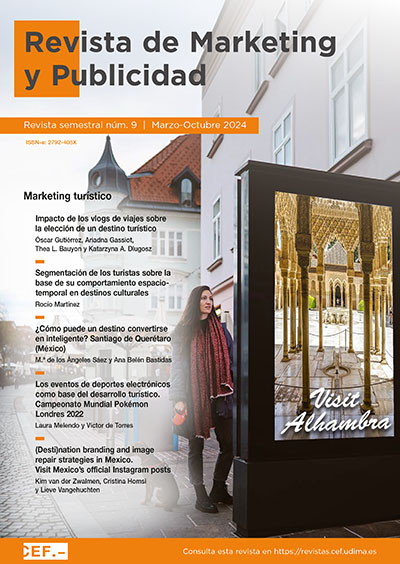Segmentación de los turistas sobre la base de su comportamiento espacio-temporal en destinos culturales
DOI:
https://doi.org/10.51302/marketing.2024.20129Palabras clave:
segmentación del turista, comportamiento intra-destino, alineamiento de secuencias, turismo culturalResumen
El objetivo del trabajo es segmentar a los turistas de acuerdo con su comportamiento espacio-temporal en un destino cultural. Para ello se analizan los lugares que visitan, el tiempo que están en cada uno de ellos y el orden en el que realizan la visita. Para poder conocer la ruta seguida por los turistas, se han usado los datos de ubicación que proporciona la cronología de Google. El análisis de datos se ha realizado usando una metodología propia de la bioinformática, el alineamiento de secuencias. El uso de esta metodología resulta fundamental para la gestión estratégica de los destinos, ya que permite mejorar la gestión de los flujos, conocer las zonas con mayor densidad de visitantes y trabajar en su descongestión. Los resultados demuestran la existencia de cuatro segmentos que se diferencian en el número de zonas visitadas y en el tiempo que dedican a su visita.
Descargas
Citas
Ahas, R., Armoogum, J., Esko, S., Ilves, M., Karus, E., Madre, J. L., Nurmi, O., Potier, F., Schmücker, D., Sonntag, U. y Tiru, M. (2014). Feasibility Study on the Use of Mobile Positioning Data for Tourism Statistics - Consolidated Report (Issue 30501).
Ashworth, G. J. y Tunbridge, J. E. (2000). The tourist-historic city. Routledge.
Bargeman, B., Joh, C. H. y Timmermans, H. (2002). Vacation behavior using a sequence alignment method. Annals of Tourism Research, 29(2), 320-337. https://doi.org/10.1016/S0160-7383(01)00065-2
Barroso, C., Martín, E. y Martín, D. (2007). The influence of market heterogeneity on the relationship between a destination’s image and tourists’ future behaviour. Tourism Management, 28(1), 175-187. https://doi.org/10.1016/j.tourman.2005.11.013
Chen, J. S., Kerstetter, D. L. y Graefe, A. R. (2001). Tourists’ reasons for visiting industrial heritage sites. Journal of Hospitality and Leisure Marketing, 8(1-2), 19-31.
Crompton, J. L. (1979). Motivations for pleasure vacation. Annals of Tourism Research, 6(4), 408-424. https://doi.org/10.1016/0160-7383(79)90004-5
Delafontaine, M., Versichele, M., Neutens, T. y Van de Weghe, N. (2012). Analysing spatiotemporal sequences in Bluetooth tracking data. Applied Geography, 34, 659-668.
Dickinson, J. E. y Peeters, P. (2014). Time, tourism consumption and sustainable development. International Journal of Tourism Research, 16(1), 11-21. https://doi.org/10.1002/jtr.1893
Donaire, J. A., Galî, N. y Royo Vela, M. (2015). El uso de GPS para el análisis del comportamiento espacio-temporal de los turistas. Pre-test en el Valle de Boí. Cuadernos de Turismo, 35, 117. https://doi.org/10.6018/turismo.35.221541
D’Urso, P. y Massari, R. (2013). Fuzzy clustering of human activity patterns. Fuzzy Sets and Systems, 215, 29-54.
Espelt, N. G. y Benito, J. A. D. (2006). Visitors’ behavior in heritage cities: The case of Girona. Journal of Travel Research, 44(4), 442-448. https://doi.org/10.1177/0047287505282956
Haldrup, M. (2004). Laid-back mobilities: Second-home holidays in time and space. Tourism Geographies, 6(4), 434-454. https://doi.org/10.1080/1461668042000280228
Hannabuss, S. (1999). Postmodernism and the heritage experience. In Library Management (vol. 20, issue 5). https://doi.org/10.1108/01435129910276280
Hartmann, R. (1988). Combining field methods in tourism research. Annals of Tourism Research, 15(1), 88-105. https://doi.org/10.1016/0160-7383(88)90073-4
INE (Instituto Nacional de Estadística). (2020). Encuesta de ocupación hotelera. https://www.ine.es/dynt3/inebase/es/index.htm?padre=238&dh=1
Kwan, M. P. (1999). Gender and individual access to urban opportunities: A study using space-time measures. The Professional Geographer, 51(2), 210-227. https://doi.org/10.1111/0033-0124.00158
Lamondia, J. J. (2010). By A Behavioral Framework for Tourism Travel Time Use and Activity Patterns.
Lau, G. y McKercher, B. (2006). Understanding tourist movement patterns in a destination: A GIS approach. Tourism and Hospitality Research, 7(1), 39-49.
Lee, H. J. y Joh, C. H. (2010). Comportement des touristes à Séoul: Analyse de la séquenced’activités touristiques en utilisant des alignements séquentiels multi dimensionnels. Tourism Geographies, 12(4), 487-504.
Lew, A. y McKercher, B. (2006). Modeling tourist movements: A local destination analysis. Annals of Tourism Research, 33(2), 403-423. https://doi.org/10.1016/j.annals.2005.12.002
McIntosh , A. J., Smith, A. e Ingram , T. (2000). Tourist experiences of Mâori culture in Aotearoa, New Zealand. Centre for Tourism Research Paper 8. University of Otago.
McKercher, B., Shoval, N., Ng, E. y Birenboim, A. (2012). First and repeat visitor behaviour: GPS tracking and GIS analysis in Hong Kong. Tourism Geographies, 14(1), 147-161.
Murphy, P. E. (1992). Data gathering for community-oriented tourism planning: Case study of Vancouver Island, British Columbia. Leisure Studies, 11(1), 65-79.
Needleman, S. B. y Wunsch, C. D. (1970). A general method applicable to the search for similarities in the amino acid sequence of two proteins. Journal of Molecular Biology, 48(3), 443-453. https://doi.org/10.1016/0022-2836(70)90057-4
Neutens, T., Schwanen, T. y Witlox, F. (2011). The prism of everyday life: Towards a new research agenda for time geography. Transport Reviews, 31(1), 25-47.
Oficina de Turismo de Granada (2020). Datos turísticos de Granada. http://www.granadatur.com/page/310-datos-turisticos/
Oppermann, M. (1992). Intranational tourist flows in Malaysia. Annals of Tourism Research, 19(3), 482-500. https://doi.org/10.1016/0160-7383(92)90132-9
Oppermann, M. (1994). Regional aspects of tourism in New Zealand. Regional Studies, 28(2), 155-167. https://doi.org/10.1080/00343409412331348146
Oppermann, M. (1995). A Model of Travel Itineraries. Journal of Travel Research, 33(4), 57-61. https://doi.org/10.1177/004728759503300409
Pearce, D. G. (1987). Spatial patterns of package tourism in Europe. Annals of Tourism Research, 14(2), 183-201. https://doi.org/10.1016/0160-7383(87)90084-3
Pearce, D. G. (1988). Tourist time-budget. Annals of Tourism Research, 15(1), 106-121.
Pearce, D. (1995). Tourism today: a geographical analysis. (2.ª ed.). Longman Scientific & Technical.
Prebensen, N. K., Vittersø, J. y Dahl, T. I. (2013). Value Co-creation significance of tourist resources. Annals of Tourism Research, 42, 240-261. https://doi.org/10.1016/j.annals.2013.01.012
Prentice, R. (2001). Experiential cultural tourism: Museums & the marketing of the new romanticism of evoked authenticity. Museum Management and Curatorship, 19(1), 5-26. https://doi.org/10.1080/09647770100201901
Saitou, N. y Nei, M. (1987). The neighbor-joining method: a new method for reconstructing phylogenetic trees. Molecular Biology and Evolution, 4(4), 406-425. https://doi.org/10.1093/oxfordjournals.molbev.a040454
Shoval, N. y Isaacson, M. (2006). Application of tracking technologies to the study of pedestrian spatial behavior. Professional Geographer, 58(2), 172-183. https://doi.org/10.1111/j.1467-9272.2006.00524.x
Shoval, N., McKercher, B., Birenboim, A. y Ng, E. (2015). The application of a sequence alignment method to the creation of typologies of tourist activity in time and space. Environment and Planning B: Planning and Design, 42(1), 76-94. https://doi.org/10.1068/b38065
Shoval, N., McKercher, B., Ng, E. y Birenboim, A. (2011). Hotel location and tourist activity in cities. Annals of Tourism Research, 38(4), 1.594-1.612. https://doi.org/10.1016/j.annals.2011.02.007
Silberberg, T. (1995). Cultural tourism and business opportunities for museums and heritage sites. Tourism Management, 16(5), 361-365. https://doi.org/10.1016/0261-5177(95)00039-Q
Steingrube, W. (1992). Der bundesdeutsche Finnland-Tourismus. Eine motiv- und verhaltensanalytische Reiseroutenuntersuchung. En Frankfurter Geographische Hefte (vol. 61). Selbstverlag.
Tchetchik, A., Fleischer, A. y Shoval, N. (2009). Segmentation of visitors to a heritage site using high-resolution time-space data. Journal of Travel Research, 48(2), 216-229. https://doi.org/10.1177/0047287509332307
Truong, T. P. y Hensher, D. A. (1985). Measurement of travel time values and opportunity cost from a discrete-choice model. The Economic Journal, 95, 438-451. https://doi.org/10.2307/2233219
Van der Knaap, W. G. M. (1997). GIS Oriented Methods for Analysing Tourist Recreation Complexes. Van der Knaap.
Van der Knaap, W. G. M. (1999). Analyse par système d’information géographique des modèles touristiques spatio-temporels pour soutenir le développement touristique durable. Tourism Geographies, 1(1), 56-69. https://doi.org/10.1080/14616689908721294
Waterman, M. S. (1998). Introduction to computational biology: maps, sequences and genomes. In Biometrics, 54(1). CRC Press. https://doi.org/10.2307/2534039
Wilson, W. C. (1998). Activity pattern analysis by means of sequence-alignment methods. Environment and Planning A, 30(6), 1.017-1.038. https://doi.org/10.1068/a301017
Xia, J. y Arrowsmith, C. (2005). Managing scale issues in spatio-temporal movement of tourists modelling. In MODSIM05 - International Congress on Modelling and Simulation: Advances and Applications for Management and Decision Making, Proceedings.
Xia, J., Evans, F. H., Spilsbury, K., Ciesielski, V., Arrowsmith, C. y Wright, G. (2010). Market segments based on the dominant movement patterns of tourists. Tourism Management, 31(4), 464-469. https://doi.org/10.1016/j.tourman.2009.04.013
Xiao-Ting, H. y Bi-Hu, W. (2012). Intra-attraction tourist spatial-temporal behaviour patterns. Tourism Geographies, 14(4), 625-645. https://doi.org/10.1080/14616688.2012.647322
Yoshimura, Y., Sobolevsky, S., Ratti, C., Girardin, F., Carrascal, J. P., Blat, J. y Sinatra, R. (2014). An analysis of visitors’ behavior in the louvre museum: A study using bluetooth data. Environment and Planning B: Planning and Design, 41(6), 1.113-1.131. https://doi.org/10.1068/b130047p
Descargas
Publicado
Cómo citar
Número
Sección
Licencia
Derechos de autor 2024 Rocío Martínez Suárez

Esta obra está bajo una licencia internacional Creative Commons Atribución-NoComercial-SinDerivadas 4.0.





















